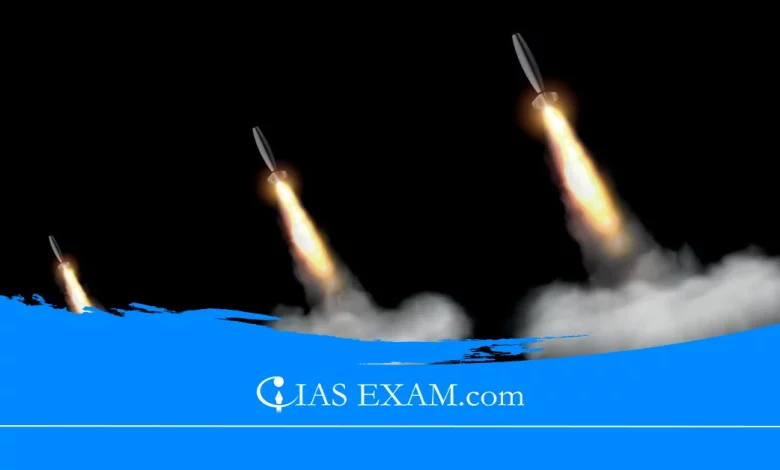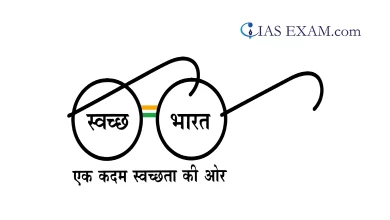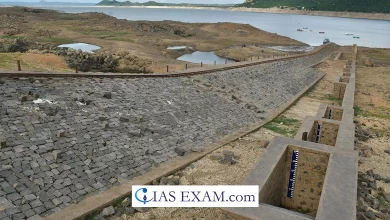The MIRV Leap and its Significance in India’s Nuclear Deterrence
GS Paper 3 - Defence Technology, Indigenization of Technology

Context
The Agni-V ballistic missile dubbed as the ‘Divyastra’ is developed by the DRDO and is strategically very consequential. With a range of more than 5000 km, Agni-V is the longest range missile India has tested so far. But it simply not just the range but also its potency which represents a watershed moment for India’s Nuclear Deterrent.
The potency of India’s deterrence is enhanced because the Agni-V variant is integrated with the MUltiple Independently Targetable Reentry Vehicles (MIRVs).
MIRVs and its Significance
- MIRVs represent a formidable advancement in missile technology due to their ability to deploy multiple warheads from a single missile platform.
- Originating in the United States in the 1970s with deployments like the Minuteman III and Poseidon missiles, MIRVs quickly became integral to the nuclear arsenals of major powers.
- The Soviet Union followed suit, developing its own MIRV technology, leading to a strategic arms race during the Cold War era. The capability to deliver multiple warheads with precision vastly increases the destructive potential of ballistic missiles, allowing for more efficient targeting of enemy assets.
- Furthermore, MIRVs serve as force multipliers, enhancing the efficiency of missile delivery systems. By enabling a single missile to strike multiple targets, MIRVs offer cost-effective solutions for military planners, particularly in the realm of submarine-launched ballistic missiles (SLBMs).
- The ability to saturate and penetrate ballistic missile defenses adds another layer of strategic advantage, making MIRVs a crucial component of modern nuclear deterrence strategies.
Comparison with other Countries
- The MIRV Technology is not new certainly for the 5 designated nuclear weapon states – the uSA, Russia, China, France and UK, but it is a first for India.
- All the nuclear weapon states except India already possessed the MIRV capable projectiles that are into their respective nuclear arsenals.
- China has emerged as a formidable player in the realm of MIRV technology, with its DF-5B ICBMs equipped with multiple warheads.
- China’s rapid expansion and modernization of its nuclear arsenal underscore the strategic significance of MIRVs in contemporary military doctrines. Additionally, Russia continues to develop advanced MIRV systems, with some missiles potentially capable of carrying up to 16 warheads.
- The proliferation of MIRV technology among nuclear-armed states highlights its enduring relevance in maintaining strategic parity and deterring potential adversaries.
- As demonstrated by India’s recent test, the possession of MIRVs signifies a nation’s technological sophistication and its capacity to safeguard national security interests in an increasingly complex geopolitical landscape.
Demanding Requirements
- Developing MIRV-capable ballistic missiles entails meeting demanding technical criteria, including warhead miniaturization, precise re-entry vehicle configuration, and guidance accuracy.
- A MIRV-based missile can only strike multiple targets that are within its gambit or geographic footprint. With the recent Agni-V test, India has met these demanding technical requirements.
- In India’s case the MIRV development is all the more impressive because it came against the backdrop of considerable odds stacked against the country’s missile and nuclear engineers.
- Inadequate nuclear testing compromised the extent to which it can miniaturize warheads and MIRV them to strike multiple targets.
- The lack of sufficient testing has also undermined the extent to which the reentry vehicles could be designed to carry the warheads.
Strategic Implications
- The introduction of MIRVs into India’s nuclear arsenal has significant implications for regional security dynamics, particularly in South Asia.
- The enhanced strike capabilities afforded by MIRVs could potentially alter the calculus of nuclear deterrence between India and its nuclear-armed neighbors, namely Pakistan and China.
- The ability to target multiple locations with precision strikes enhances India’s capacity to deter aggression and respond effectively to any threat scenario.
- Furthermore, the development of MIRV technology underscores India’s commitment to maintaining a credible and robust nuclear deterrence posture in the face of evolving security challenges.
- By diversifying its nuclear arsenal and incorporating advanced technologies like MIRVs, India seeks to reinforce its status as a responsible nuclear power while simultaneously deterring potential adversaries from engaging in hostile actions.
Way Forward
India’s acquisition of MIRV technology represents a significant development in its nuclear deterrence strategy, with far-reaching implications for regional security dynamics. While the deployment of MIRVs enhances India’s strike capabilities and strengthens its deterrence posture, it also raises important strategic considerations and challenges. As India continues to modernize its nuclear arsenal, it must navigate these complexities with prudence and foresight, prioritizing stability, and security in the region.
SOURCE: The Hindu





.png)



